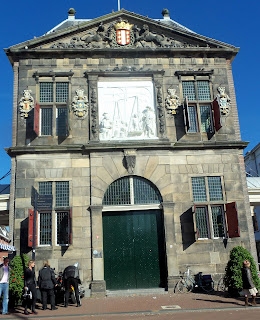At the Museum De Gevangenpoort (Prison Gate Museum) you can see relics of medieval justice in action. It's the former prison of the Court of Holland and it sports a unique collection of punishment and torture (enhanced interrogation) instruments. You can visit the Jailer's Quarters, the labyrinthine Cell Complex, the Interrogation Room and the Judge's Chambers. Linnea suggested we join the Halloween Night tour, but I demurred.
Aristocrat, statesmen, peacemaker and polymath Johan De Witt, de facto head of the Dutch Republic from around 1650 until shortly before his spectacular death in 1672, was imprisoned here.
De Witt brought the First Anglo-Dutch War to a peaceful end by making a secret deal with Oliver Cromwell to never allow the son of the Dutch regent Willem II (1626 – 650) - the future Willam III - to be named "Stadholder", or de fact head of the Dutch Republic. Reason being - that baby Willem III (
1650-1722) was the grandson (on his mother's side) of the same Stuart King who Oliver Cromwell had beheaded, Charles I, and thus young Willem III was a potential claimant to the English throne.
Long story short, De Witt's agreement was discovered by the royals and he was imprisoned for treason along with his brother Cornelis (despite the fact Cornelis was a national naval hero), both were tortur... enhanced interrogated and ordered to be banished. But the hapless brothers were grabbed by an ungrateful lynch mob and dismembered. Bits of their bodies were sold off as souvenirs, and at the nearby Haags Historisch Museum you can view the salt-cured preserved tongue of Johan de Witt and a toe of his brother Cornelis. No, really.
+ + +
The Binnenhoff
The Binnenhoff (Dutch for "Inner Court") has been the meeting place of the Dutch Parliment since 1446. It also contains an office for royalty, in the current incarnation, Queen Beatrix, and the Ridderzaal (Knights Hall), dating from 1250.
The Ridderzaal
gold-plated dogs puking water?
Last time we visited the Binnenhoff there was something big going on.
The place was filled with black sedans, police, palace guards and men in dark suits.
There were no visitor restrictions, however.



















































